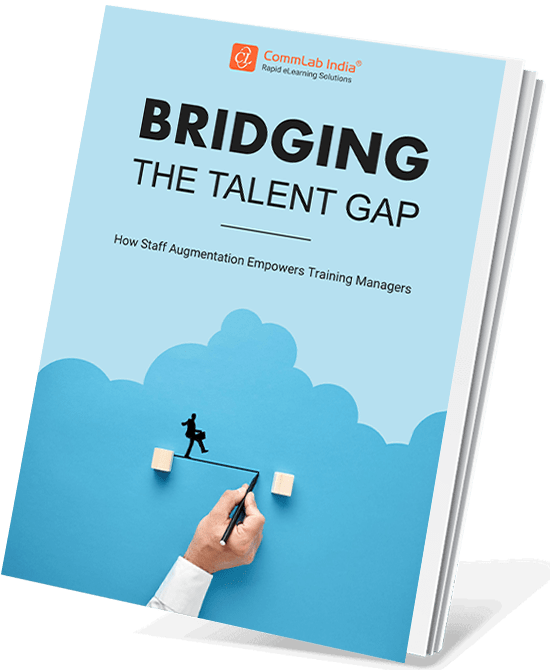L&D Staff Augmentation VS. Outsourcing — When to Pick What?

In today's dynamic and fiercely competitive business landscape, the importance of Learning and Development (L&D) cannot be overstated. Organizations are increasingly recognizing that a well-trained and continuously upskilled workforce is the key to innovation, adaptability, and sustained success. However, building and maintaining a robust L&D function presents its own set of challenges. In the quest to optimize their L&D staffing strategies, organizations are increasingly turning to two prominent approaches: staff augmentation and outsourcing. In this comprehensive blog post, we will discuss the nuances of L&D staff augmentation and outsourcing, exploring their definitions, mechanics, benefits, and drawbacks.
→ Download eBook Now: Staff Augmentation for L&D Teams
Table of Contents
- What is L&D Staff Augmentation?
- What is L&D Outsourcing?
- What are the Key Factors in the Decision-Making Process?
- What are the Key Criteria for the Selection of Vendor/Provider?
- What are Various Hybrid Approaches and Emerging Trends?
- Let’s Explore a Few Real-Life Examples!
The demand for skilled L&D professionals often outstrips supply, and organizations grapple with the complexities of balancing the need for specialized expertise with budgetary constraints and long-term strategic goals. These alternatives offer distinct advantages and considerations, each catering to specific organizational needs and circumstances. Staff augmentation provides the flexibility to temporarily expand your L&D team with skilled professionals, while outsourcing entails entrusting L&D functions entirely or partially to an external provider.
Confused Between Staff Augmentation and Outsourcing?
Here are a few key factors you should consider
- Project scope and duration
- Budgetary considerations
- Internal L&D capabilities
- Need for specialized skills
- Level of control desired
What is L&D Staff Augmentation?
L&D staff augmentation is a strategic staffing approach that allows organizations to temporarily enhance their in-house L&D capabilities by bringing in skilled external professionals. Think of it as a way to "rent" expertise for a specific project or timeframe, providing your existing team with additional support and specialized skills. When you opt for L&D staff augmentation, you partner with a staffing agency or consultancy that specializes in providing L&D talent. They carefully assess your needs, project scope, and desired skillset to identify the ideal professionals to join your team. These professionals are then seamlessly integrated into your existing L&D function, working alongside your internal staff to achieve specific goals.

Advantages of L&D Staff Augmentation
- Flexibility and Scalability: One of the primary advantages of staff augmentation is its inherent flexibility. You can quickly ramp up your L&D resources during peak periods or for specific projects, and then scale back down when the demand subsides, avoiding the long-term commitments associated with hiring full-time employees.
- Access to Specialized Skills: Need an instructional designer with expertise in virtual reality training or a data analyst to measure the impact of your L&D programs? Staff augmentation provides a gateway to a vast pool of specialized talent, allowing you to tap into niche skills that might not be readily available within your organization.
- Cost-Effectiveness: Compared to the costs of hiring, onboarding and training full-time employees, staff augmentation can be a more cost-efficient solution, particularly for short-term or project-based needs.
- Knowledge Transfer: By working alongside your existing L&D staff, augmented professionals can share their knowledge and expertise, fostering a learning environment that benefits your entire team.
Disadvantages of L&D Staff Augmentation
- Potential Integration Challenges: While the goal is seamless integration, there's always a possibility of challenges as external professionals adapt to your organization's culture, processes, and systems.
- Management Overhead: Managing a blend of internal and external L&D staff requires additional coordination and oversight, which can add to your managerial workload.
- Limited Long-Term Commitment: Augmented staff are typically engaged on a temporary basis, which might not be ideal if you're looking for long-term continuity and deep organizational knowledge.
When Staff Augmentation Shines
L&D staff augmentation is particularly well-suited for scenarios where you need specialized skills for a specific project or timeframe, require flexibility to scale your team up or down quickly, or want to supplement your internal L&D expertise without making long-term commitments.

What is L&D Outsourcing?
L&D outsourcing involves delegating specific or all of your L&D functions to an external provider, often a specialized L&D firm or consultancy. It's a more comprehensive approach compared to staff augmentation, as it shifts the responsibility for certain L&D aspects or the entire function outside of your organization. When you outsource L&D, you enter into a contractual agreement with an external provider who assumes responsibility for delivering specific L&D services. This can range from designing and developing training programs to managing your learning management system (LMS) or providing ongoing L&D support.
Advantages of L&D Outsourcing
- Focus on Core Competencies: Outsourcing allows you to free up internal resources and focus your attention on your core business activities.
- Access to a Wider Pool of Expertise: External L&D providers often have a broad and deep pool of specialized talent, providing access to expertise that might be beyond the reach of your internal team.
- Reduced Costs: Outsourcing can lead to significant cost savings, particularly when compared to the expenses associated with maintaining a full-fledged in-house L&D function.
- Risk Mitigation: L&D providers often assume responsibility for managing the risks associated with L&D initiatives, such as ensuring compliance with regulatory requirements or staying abreast of the latest learning technologies.
Disadvantages of L&D Outsourcing
- Loss of Control: When you outsource L&D, you relinquish a certain degree of control over the processes and outcomes, which might not be comfortable for organizations that value high levels of oversight.
- Potential Communication Barriers: Effective communication is essential for successful outsourcing, but there's always a risk of misinterpretations or delays, particularly when working with providers in different time zones or cultural contexts.
- Cultural Misalignment: The external provider's culture and values might not perfectly align with your organization's, which could lead to friction or challenges in collaboration.
- Dependency on External Provider: Outsourcing creates a dependency on the external provider for critical L&D functions, which can be a vulnerability if the relationship sours or the provider faces challenges.
When L&D Outsourcing Makes Sense
L&D outsourcing is an attractive option for organizations seeking to reduce costs, gain access to specialized expertise, free up internal resources to focus on core activities, or mitigate risks associated with L&D initiatives. It's particularly beneficial for organizations that lack a robust internal L&D function or those looking to outsource specific L&D tasks that are not core to their business.

Bridging the Talent Gap: How Staff Augmentation Empowers Training Managers
Craft a Dream Team of Exceptional Experts, Meticulously Suited to your Requirements!
- Advantages and Considerations of Staff Augmentation
- L&D Roles that Benefit from Staff Augmentation
- Staff Augmentation Process
- Success Stories
What are the Key Factors in the Decision-Making Process?
Choosing between L&D staff augmentation and outsourcing isn't a one-size-fits-all decision. It requires a careful evaluation of various factors to determine the most suitable approach for your organization's specific needs and circumstances.
Project Scope and Duration
- Short-Term, Specialized Projects: If you have a short-term project that requires specific L&D skills, staff augmentation might be the more agile option. You can quickly bring in experts for the duration of the project and then scale back down when it's complete.
- Long-Term, Comprehensive Initiatives: For large-scale or ongoing L&D initiatives, outsourcing can offer greater stability and continuity. An external provider can assume responsibility for the entire L&D function or specific aspects, providing long-term support and expertise.
Budgetary Considerations
- Cost Analysis: It's essential to conduct a thorough cost analysis to compare the financial implications of staff augmentation and outsourcing. Consider not only the direct costs, such as salaries or fees, but also the indirect costs, such as management overhead, integration efforts, or potential communication challenges.
- Hidden Costs: Be mindful of hidden costs that might not be immediately apparent. For example, staff augmentation might require additional investments in onboarding and training, while outsourcing might involve contract negotiation and ongoing relationship management expenses.
Internal L&D Capabilities
- Strong Internal Team: If you have a robust internal L&D team with a wide range of skills, staff augmentation might be preferable, allowing you to supplement your existing expertise as needed.
- Limited In-House Expertise: Organizations lacking in-house L&D capabilities might benefit from outsourcing, gaining access to a broader pool of talent and specialized skills. Here’s a short video to help you understand how you can find the right outsourcing partner.
Need for Specialized Skills
Niche Expertise: If your L&D requirements need niche or highly specialized skills, staff augmentation might be the better choice. You can target specific professionals with the exact expertise you need for your project.
Level of Control Desired
- High Control: Organizations that prefer to maintain a high degree of control over their L&D processes and outcomes might gravitate towards staff augmentation, as it allows for closer collaboration and oversight.
- Delegation Comfort: If you're comfortable delegating L&D responsibilities and trust external providers to manage the function effectively, outsourcing can be a viable solution.
Other Considerations
- Company Culture: Consider whether the external provider's culture aligns with your organization's values, learning culture, and work style.
- Data Security and Confidentiality: Ensure that adequate measures are in place to protect sensitive data and maintain confidentiality, especially when outsourcing.
- Scalability: Assess the flexibility of each approach to scale up or down based on your evolving L&D needs.
What are the Key Criteria for the Selection of Vendor/Provider?
Whether you're leaning towards staff augmentation or outsourcing, the success of your L&D initiatives hinges significantly on selecting the right provider. Making an informed choice requires a thorough evaluation of potential partners based on key criteria that align with your organization's needs and goals.
Experience and Expertise
- L&D Specialization: Look for providers with a proven track record and deep expertise in the L&D field. They should understand the nuances of adult learning, instructional design, and learning technologies.
- Industry Knowledge: If your organization operates in a specific industry, consider providers with experience in that sector. They'll be better equipped to understand your unique challenges and tailor L&D solutions accordingly.
- Skillset Alignment: Ensure the provider's capabilities align with your specific L&D needs. Whether you require instructional designers, eLearning developers, facilitators, or data analysts, they should have the right talent pool to meet your requirements.
Track Record and Client References
- Successful Projects: Ask for examples of successful projects the provider has completed, ideally in similar industries or with comparable L&D needs.
- Client Testimonials: Request references from past or current clients to gain insights into their experiences working with the provider.
- Case Studies: Review case studies or success stories showcasing the provider's ability to deliver results and address L&D challenges effectively. For example,
Cultural Fit and Communication
- Shared Values: Assess whether the provider's culture and values align with your organization's. A good cultural fit can foster smoother collaboration and better outcomes.
- Communication Style: Evaluate their communication style and responsiveness. Clear and open communication is essential for a successful partnership.
- Collaboration Approach: Inquire about their approach to collaboration and project management. Ensure it aligns with your preferred working style. Here are a few platforms you can utilize for seamless collaboration.
Technological Capabilities
- Learning Technologies: If you're utilizing specific learning technologies or platforms, ensure the provider has experience with them or is willing to adapt.
- Infrastructure: Evaluate their technological infrastructure and capabilities to ensure they can support your L&D needs, especially if you require virtual or online learning solutions.
- Data Security: Confirm that they have robust data security measures in place to protect sensitive learner information and comply with relevant regulations.
Pricing and Contract Terms
- Transparent Pricing: Request a clear and detailed breakdown of their pricing structure. Understand what's included and what might incur additional costs.
- Contract Flexibility: Negotiate contract terms that offer flexibility and scalability, allowing you to adjust the scope of services as your L&D needs evolve.
- Performance Metrics: Include performance metrics or service-level agreements (SLAs) in the contract to ensure accountability and track progress.
Additional Considerations
- Innovation and Thought Leadership: Look for providers who stay abreast of the latest L&D trends and technologies, demonstrating a commitment to innovation and thought leadership.
- Accessibility and Inclusion: Ensure the provider is committed to creating accessible and inclusive learning experiences for all learners.
- Social Responsibility: Consider whether the provider's values and practices align with your organization's commitment to social responsibility and sustainability.
By carefully evaluating potential L&D providers based on these key criteria, you can increase your chances of finding the right partner to support your L&D initiatives, whether you're opting for staff augmentation or outsourcing. Remember, a strong partnership with a reliable and capable L&D provider can be a catalyst for achieving your L&D goals and driving organizational success.
What are Various Hybrid Approaches and Emerging Trends?
The L&D landscape is constantly evolving, and rigid adherence to a single staffing approach might not always be the optimal solution. In today's dynamic environment, organizations are increasingly exploring hybrid approaches, blending staff augmentation and outsourcing to leverage the strengths of both models.
Blending Staff Augmentation and Outsourcing: The Best of Both Worlds
Organizations are recognizing the potential of combining staff augmentation and outsourcing to create a hybrid L&D staffing model that leverages the unique strengths of each approach. This blended approach can offer a powerful combination of flexibility, expertise, and cost-efficiency.
1. Core Functions Outsourced, Specialized Skills Augmented
A common hybrid model involves outsourcing core L&D functions that require ongoing support and maintenance, such as managing your learning management system (LMS) or providing basic compliance training. At the same time, you can utilize staff augmentation to bring in specialized expertise for specific projects or niche skill requirements, such as developing a cutting-edge virtual reality training program or conducting a comprehensive L&D needs analysis.
2. Phased Approach
Another hybrid strategy involves a phased approach, starting with staff augmentation to address immediate L&D needs and then gradually transitioning to outsourcing as your requirements grow or evolve. This allows you to test the waters with external providers and build a relationship before committing to a long-term outsourcing arrangement.
Emerging Trends in L&D Staffing: Embracing Innovation
The L&D landscape is constantly evolving, and organizations need to stay abreast of emerging trends to ensure their staffing strategies remain effective and aligned with the changing needs of the workforce.
1. Rise of Freelance L&D Professionals
The gig economy is transforming the way organizations access L&D talent. A growing number of highly skilled instructional designers, eLearning developers, facilitators, and other L&D professionals are choosing to work independently, offering their services on a project or contract basis. This provides organizations with even greater flexibility and access to a wider pool of specialized expertise.
2. AI-Powered L&D Platforms
Artificial intelligence (AI) is revolutionizing the L&D field, with platforms that can automate content creation, personalize learning experiences, and provide data-driven insights into learner behavior and performance. Leveraging AI-powered tools can help organizations streamline their L&D operations, improve efficiency, and deliver more targeted and impactful learning experiences.

The Importance of Adaptability: Staying Ahead of the Curve
In the fast-paced world of L&D, flexibility and adaptability are paramount. The ideal L&D staffing solution might not be static, but rather a dynamic blend of strategies that evolve along with your organizational needs and the broader L&D landscape.
It's essential to continuously assess your L&D requirements, explore new approaches, and leverage emerging technologies to ensure your staffing strategies remain effective and aligned with the ever-changing needs of your workforce. By embracing innovation and remaining adaptable, you can build a resilient and future-ready L&D function that drives organizational success.
Let’s Explore a Few Real-Life Examples!
Case Study 1: Tech Startup Embraces Staff Augmentation
A rapidly growing tech startup desired to develop a comprehensive onboarding program for its expanding workforce. However, their internal L&D team was already stretched thin with other priorities. They opted for staff augmentation, bringing in an experienced instructional designer and eLearning developer to collaborate with their existing team.
Factors Influencing the Decision:
- Need for specialized skills (instructional design and eLearning development)
- Short-term project with a defined scope
- Desire to maintain control over the process and outcomes
- Limited budget for long-term commitments
Outcomes:
- The augmented team successfully designed and developed an engaging and effective onboarding program within the desired timeframe.
- Internal L&D staff benefited from knowledge transfer and collaboration with the external professionals.
- The startup achieved its goal of providing a seamless onboarding experience for new hires, contributing to improved employee engagement and retention.
Case Study 2: Global Corporation Opts for Outsourcing
A multinational corporation with operations across multiple continents was facing challenges in maintaining consistency and quality in its L&D programs across different regions. They decided to outsource their entire L&D function to a global L&D provider.
Factors Influencing the Decision:
- Need for a comprehensive L&D solution across multiple geographies
- Desire to reduce costs and free up internal resources
- Access to a wider pool of L&D expertise and global best practices
- Focus on core business activities
Outcomes:
- The external L&D provider streamlined and standardized the corporation's L&D programs, ensuring consistency and quality across all regions.
- The corporation benefited from cost savings and improved efficiency in its L&D operations.
- Internal HR and business leaders were able to focus on strategic initiatives, driving organizational growth.
These case studies illustrate the diverse applications of L&D staff augmentation and outsourcing. Each organization faced unique challenges and chose the approach that best aligned with their specific needs, ultimately achieving their L&D goals and contributing to overall business success.
Remember, there's no single "right" answer when it comes to choosing between L&D staff augmentation and outsourcing. It's about carefully considering your organization's context, goals, and resources to select the approach that empowers you to build a thriving L&D function and foster a culture of continuous learning and development.
Conclusion: Choosing the Right Path for L&D Success
In this in-depth exploration of L&D staff augmentation and outsourcing, we've navigated the complexities of these two strategic staffing approaches. The decision of which approach to choose hinges on a careful consideration of various factors, including project scope, budget, internal capabilities, the need for specialized skills, and the level of control desired.
Whether you choose staff augmentation, outsourcing, or a hybrid approach, the key is to adopt a strategic and flexible mindset, continuously evaluating your needs and leveraging the available resources to build a thriving L&D ecosystem that fosters a culture of continuous learning and development. To help with one of the two choices here, here’s a free eBook to learn more about staff augmentation, check it out now!






